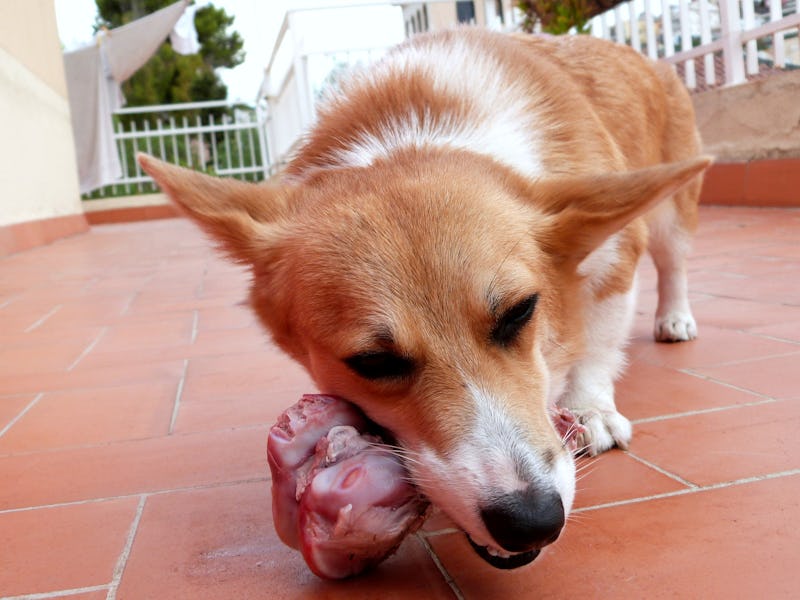Why You Should Think Twice Before Putting Your Dog on a Raw Meat Diet
Maybe just stick with Beggin' strips.

Just as many people are trying to eat less processed food to improve their health, some dog owners are turning away from conventional pet food. Instead they’re trying to get back to what they see as a more traditional “butcher’s dog” diet of raw meat, albeit with pre-prepared products that can be served easily and frozen for convenience.
A recent study has raised concerns about the health risks of these raw meat-based diet products as possible sources of some bacterial and parasitic diseases. But just how big a problem is this, and who is really at risk?
First, it’s worth pointing out that the evidence for the health advantages of raw meat-based diets is limited. Some research suggests they may enhance an animal’s overall digestion (and so the size of their poos). But robust comparative studies are rare, and there are still concerns about whether some of these diets provide enough nutritional value.
See also: A Neuroscientist Explains Why You Can’t Help But Love Kittens
Domestic dogs aren’t like wild carnivores. They have been evolving alongside humans for approximately 30,000 years, and their diet has been shaped by our own food and environment. They can easily survive on a mixed diet, often on waste from human settlements, and have even evolved to digest starch.
Traditional dog diets would have included raw meat but also table scraps and other homemade foods. And unlike most human processed foods, manufactured pet food is often tailored to provide a key range of nutrients. After all, the move to commercial pet food coincided with increased research into the nutritional requirements of the dog.
The recent study in the [Veterinary Record](http://veterinaryrecord.bmj.com/content/182/2/50) analyzed 35 commercial frozen raw meat products from eight different brands. It found E. coli in 28 products, Listeria monocytogenes in 19 of them, and Salmonella species in seven. Several products also contained parasites. Other studies have previously highlighted similar contamination of raw pet food in Canada, North America, and New Zealand.
By comparison, unprocessed raw meat from the butcher is less likely to be an issue than the products in the study, in the same way it is safer to eat rare steak than raw mince. The problem is that there is no study comparing commercially produced raw dog food with small batches of raw butcher’s meat, so we can’t be certain about how much riskier these manufactured products are.
For dogs, the bacteria and parasites found in food aren’t actually that much of a problem. Dogs are pretty resistant to many of the possible bugs that can be isolated from raw meat, and they rarely become ill, though they can suffer gastric illness as a result of Salmonella.
But dogs can become carriers of these bacteria and spread them through their feces, which can lead to serious illness in humans.
What is especially significant is these food products’ level of contamination with bacteria that are resistant to treatment with antibiotics. This is a concern for both pet and human health. Infections with these bacteria are increasingly difficult to treat, and the spread of antibiotic resistance is a critical public health issue.
The parasitic pathogens found in the products can cause significant health problems but aren’t as common and can mostly be inactivated by freezing the food at -20 degrees Celcius.
Minimizing the Risks
For all the threat that this contamination poses, it’s worth remembering that many human food products are full of similar bugs. The UK Food Standards Agency recently reported that antibiotic-resistant superbugs were found at record levels in supermarket chickens. Even bags of salad can contain Salmonella.
The same guidance for storing and preparing food for human consumption applies to raw meat pet food. Wash hands and surfaces thoroughly and often. Separate different foods to prevent cross-contamination. Defrost frozen items in the fridge, ideally in sealed containers and on the lowest shelves. Handle pet food bowls with care to prevent bacteria from spreading to other surfaces and utensils.
See also: Why Dogs Look Like Their Owners, According to Science
Where the dangers from pet food differ is in the fact that pets can pass on bugs after they’ve eaten. Owners can become exposed in a range of ways, such as direct contact via touching, petting, exposure to saliva and feces, and even sharing sleeping spaces. Bugs can also be passed on indirectly through contact with contaminated surfaces such as floors and toys.
But sensibly handling, cleaning, and caring for your dog should minimize the risks. Wash your hands with soap and hot water after handling your dogs’ food and after poo picking. Store human and pet bowls and utensils separately and, if possible, keep your dog out of human food preparation areas. With a little education and awareness, it is possible to go for raw food and minimize the potential risks.
This article was originally published on The Conversation by Jacqueline Boyd. Read the original article here.